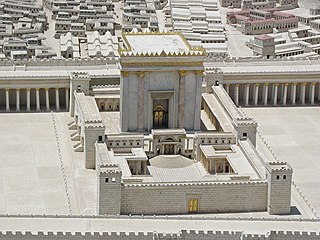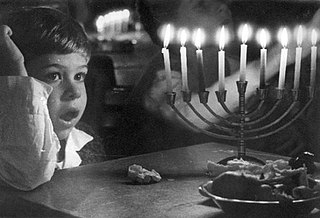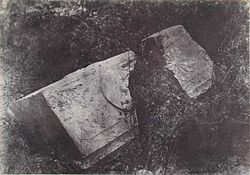
The Temple in Jerusalem, or alternatively the Holy Temple, refers to the two religious structures that served as the central places of worship for Israelites and Jews on the modern-day Temple Mount in the Old City of Jerusalem. According to the Hebrew Bible, the First Temple was built in the 10th century BCE, during the reign of Solomon over the United Kingdom of Israel. It stood until c. 587 BCE, when it was destroyed during the Babylonian siege of Jerusalem. Almost a century later, the First Temple was replaced by the Second Temple, which was built after the Neo-Babylonian Empire was conquered by the Achaemenid Persian Empire. While the Second Temple stood for a longer period of time than the First Temple, it was likewise destroyed during the Roman siege of Jerusalem in 70 CE.

The Second Temple, later known as Herod's Temple, was the reconstructed Temple in Jerusalem between c. 516 BCE and 70 CE. Defining the Second Temple period, it stood as a pivotal symbol of Jewish identity and was central to Second Temple Judaism; it was the chief place of worship, ritual sacrifice (korban), and communal gathering for Jews. As such, it attracted Jewish pilgrims from distant lands during the Three Pilgrimage Festivals: Passover, Shavuot, and Sukkot.
The Sadducees were a sect of Jews active in Judea during the Second Temple period, from the second century BCE to the destruction of the Second Temple in 70 CE. The Sadducees are described in contemporary literary sources in contrast to the two other major sects at the time, the Pharisees and the Essenes.
In the Hebrew Bible, a nazirite or a nazarite is a man or woman who voluntarily took a vow which is described in Numbers 6:1–21. This vow required the nazirite to:

Adiabene was an ancient kingdom in northern Mesopotamia, corresponding to the northwestern part of ancient Assyria. The size of the kingdom varied over time; initially encompassing an area between the Zab Rivers, it eventually gained control of Nineveh and starting at least with the rule of Monobazos I, Gordyene became an Adiabenian dependency. It reached its zenith under Izates II, who was granted the district of Nisibis by the Parthian king Artabanus II as a reward for helping him regain his throne. Adiabene's eastern borders stopped at the Zagros Mountains, adjacent to the region of Media. Arbela served as the capital of Adiabene.

Rabbinic Judaism, also called Rabbinism, Rabbinicism, or Rabbanite Judaism, has been the mainstream form of Judaism since the 6th century CE, after the codification of the Babylonian Talmud. Rabbinic Judaism has its roots in the Pharisaic school of Second Temple Judaism, and is based on the belief that Moses at Mount Sinai received both the Written Torah and the Oral Torah from God. The Oral Torah, transmitted orally, explains the Written Torah. At first, it was forbidden to write down the Oral Torah, but after the destruction of the Second Temple, it was decided to write it down in the form of the Talmud and other rabbinic texts for the sake of preservation.

Judaea was a Roman province from 6 to 132 CE, which incorporated the Levantine regions of Judea, Samaria and Idumea, extending over parts of the former regions of the Hasmonean and Herodian kingdoms of Judea. The name Judaea was derived from the Iron Age Kingdom of Judah.

Simeon the Righteous or Simeon the Just was a Jewish High Priest during the Second Temple period. He is also referred to in the Mishnah, where he is described as one of the last members of the Great Assembly.

Naso or Nasso is the 35th weekly Torah portion in the annual Jewish cycle of Torah reading and the second in the Book of Numbers. It constitutes Numbers 4:21–7:89. The parashah addresses priestly duties, camp purification, restitution for wrongs committed, the wife accused of unfaithfulness, the nazirite, the Priestly Blessing, and consecration of the Tabernacle. Naso has the largest number of letters, words, and verses of any of the 54 weekly Torah portions. The parashah is made up of 8,632 Hebrew letters, 2,264 Hebrew words, 176 verses, and 311 lines in a Torah Scroll.

Matot, Mattot, Mattoth, or Matos is the 42nd weekly Torah portion in the annual Jewish cycle of Torah reading and the ninth in the Book of Numbers. It comprises Numbers 30:2–32:42. It discusses laws of vows, the destruction of Midianite towns, and negotiations of the Reubanites and Gadites to settle land outside of Israel.
Monobaz I was king of the Parthian client state of Adiabene in the 20s and 30s of the 1st century AD. He was the husband of Queen Helena of Adiabene. With Helena he fathered Izates bar Monobaz and Monobaz II. Midrash Genesis Rabbah 46:10 conflates the identity of Monobaz I with King Ptolemy, “‘And circumcise the flesh of your foreskin’ : [The foreskin] hangs on the body like a sore (nomi). It happened that king Munbaz and Zawatus (=Izates), the sons of King Ptolemy, were sitting and reading the book of Genesis. When they came to this verse, ‘and circumcise the flesh of your foreskin,’ one turned his face to the wall and began to cry, and the other turned his face to the wall and [also] began to cry.[21] Then each of them went and had himself circumcised [without the other knowing].”
Monobazus II was the son of Queen Helena of Adiabene and King Monobazus I. He is known as Monobaz in the Babylonian Talmud.
Ananias of Adiabene was a Jewish merchant and mendicant proselytizer, probably of Hellenistic origin, who, in the opening years of the common era, was prominent at the court of Abinergaos I (Abennerig), king of Characene. He was instrumental in the conversion to Judaism of numerous native and foreign inhabitants of Charax Spasinu. This city, the capital of Characene, was situated at the confluence of the two arms of the Tigris near the Persian Gulf and was at the time a great mercantile center.

Tractate Middot is the tenth tractate of Seder Kodashim of the Mishnah and of the Talmud. This tractate describes the dimensions and the arrangement of the Temple Mount in Jerusalem, and the Second Temple buildings and courtyards, various gates, the altar of sacrifice and its surroundings, and the places where the Priests and Levites kept watch in the Temple.

Judea or Judaea is a mountainous region of the Levant. Traditionally dominated by the city of Jerusalem, it is now part of Palestine and Israel. The name's usage is historic, having been used in antiquity and still into the present day; it originates from Yehudah, a Hebrew name. Yehudah was a son of Jacob, who was later given the name "Israel" and whose sons collectively headed the Twelve Tribes of Israel. Yehudah's progeny among the Israelites formed the Tribe of Judah, with whom the Kingdom of Judah is associated. Related nomenclature continued to be used under the rule of the Babylonians, the Persians, the Greeks, and the Romans. Under the Hasmoneans, the Herodians, and the Romans, the term was applied to an area larger than the historical region of Judea. In 132 CE, the Roman province of Judaea was merged with Galilee to form the enlarged province of Syria Palaestina.

The Tombs of the Kings are a rock-cut funerary complex in East Jerusalem believed to be the burial site of Queen Helene of Adiabene, hence: Helena's Monuments. The tombs are located 820 m (2,690 ft) north of Jerusalem's Old City walls in the Sheikh Jarrah neighborhood

Jerusalem during the Second Temple period describes the history of Jerusalem during the Second Temple period, from the return to Zion under Cyrus the Great to the siege and destruction the city by Titus during the First Jewish–Roman War. During this period, which saw the region and city change hands several times, Jerusalem was the center of religious life for all Jews; even those who lived in the diaspora prayed towards Jerusalem on a daily basis and made pilgrimages during religious festivals. Under Hasmonean and Herodian rule, Jerusalem served as a royal capital and the seat of all major national institutions. In Jerusalem, the Pharisees of Second Temple Judaism developed into the Tannaim and Judaism's post-Exilic religious identity as it continues today, and the Hebrew Bible was perhaps canonized, although exactly when this occurred remains disputed. It was also in Jerusalem during the later stages of this period that Christianity was born.

Louis Félicien Joseph Caignart de Saulcy, better known as simply Félicien or Félix de Saulcy, was a French numismatist, Orientalist, and archaeologist.
This article presents a timeline of the name Judea through an incomplete list of notable historical references to the name through the various time periods of the region.

















